WHAT'S NEW ACROSS THE WORLD
What's
new April 2000
What's
new July 2000
What's
new October 2000
What's
new January 2001
| What's New ©by
Laif DeMason
Cichlid interests and the resultant sales have
noticeably increased over the last few weeks. Various weather-related problems
associated with shipping and collecting are on the wane, but nevertheless
continue to affect sales. Still, there is a definite buying trend
that is hard to ignore. Prices of export fishes from some areas have
nudged upwards due to higher fuel costs in underdeveloped nations.
However importers are absorbing the brunt of these increases for now, rather
than pass them on to the consumer. Not much has changed in hobbyist
tastes within the various cichlid specialization departments over the last
year or so. It will be interesting to see if any one cichlid group
or genus will now emerge as a new “must-have” fad, as has happened so many
times in the past.
Here’s “what’s new” on the cichlid scene: |
Lake Tanganyika
Apart from the heavy rains that have plagued the southern regions, exports
are as per usual. The most popular species from Lake Tanganyika are various
lamprologines, small Tropheus, and various oddities. Wild-caught
Cyprichromis have gained some popularity of late.
|
what's new: Lake Tanganyika
|
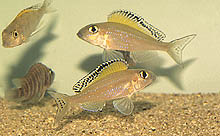
Collected north of Kipili, Xenotilapia spilopterus
is known for its unique yellow dorsal fin. |
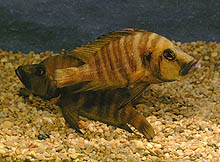
From southern areas, Altolamprologus compressiceps
“Mwela” sports a pleasant coppery-orange color. |

Exported from Zambia, a new variety of Paracyprichromis
brieni called “primrose” shows a strong yellow hue in the anal fin. |
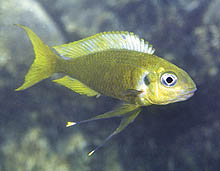
A recent export, this variety of Ophthalmotilapia
ventralis “yellow” is from Kala, Tanzania. Photo by A. Konings. |
Lake Malawi
For a variety of reasons, exports of wild-caught Malawi stocks have
slowed. Sales are still brisk, however, from Florida farms and bred
sources. Popular items include small colorful mbuna, large Aulonocara
males, and many hard to get oddities. Malawi cichlids at small sizes
are still one of the most popularly-purchased items.
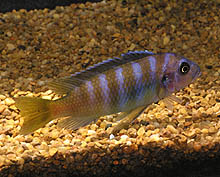
Caught north of Cape Kaiser, Tanzania, Pseudotropheus
sp. “zebra yellow tail” is an elongated form that is rarely exported. |
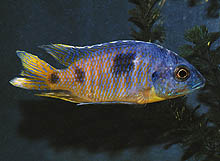
Related to Otopharynx heterodon, this O.
sp. “big spot Tanzania” is characterized by the large spots on its flanks. |
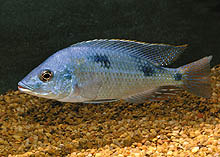
Popular in the early days of Malawi cichlid-keeping,
Hemitilapia oxyrhynchus is available again from bred sources and
occasionally from the wild. |
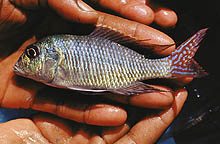
Exported from Tanzania, this unidentified species
of Lethrinops is similar to some of the “green face” varieties,
which are exported from southeast Malawi. Photo by C. Kacirek. |
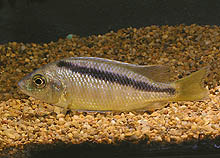
Occasionally exported and available from bred sources
is the yellow Mylochromis melanonotus. |
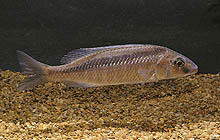
This rarely-exported, torpedo-shaped predator with
a black longitudinal stripe is likely Mylochromis formosus. |
Victoria
The cichlid scene regarding the Victorian basin remains unchanged.
There is renewed talk of exports, but the best source is still from breeders.
Popular varieties include many of the old stand-bys from ten years ago.

Originally from Uganda, ‘Haplochromis’ sp.
“madonna” can still be found from specialized breeders. |
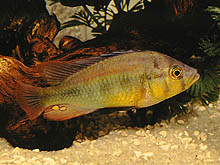 From Lake Albert and elsewhere (most areas held by rebels), ‘Haplochromis’
aeneocolor is popular due to its bright yellow underbody.
From Lake Albert and elsewhere (most areas held by rebels), ‘Haplochromis’
aeneocolor is popular due to its bright yellow underbody. |
Neotropics
Neotropical cichlid buffs maintain a stronghold of favorite selections.
Wild caught discus and dwarf cichlids are still popular, as are geophagines
and odd selections of Central America cichlids from bred sources.
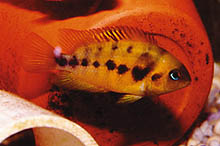
Originally from Panama, Archocentrus nanoluteus
is a low-aggression cichlasomine. Photo by J. Rapps. |
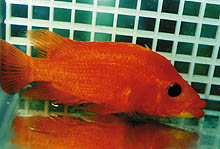
Caught in Nicaragua, wild Amphilophus labiatus
are occasionally seen in full breeding dress. Photo by J. Rapps. |

With several color variants available (from different
locations), Apistogramma agassizzi is very popular. A male
Ap. agassizzi “red” is pictured here. |
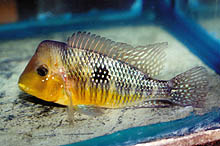
Originally from Uruguay, Gymnogeophagus cf. gymnogenys
“Salto” has atypical vertical bars. Photo by J. Rapps. |
|











 From Lake Albert and elsewhere (most areas held by rebels), ‘Haplochromis’
aeneocolor is popular due to its bright yellow underbody.
From Lake Albert and elsewhere (most areas held by rebels), ‘Haplochromis’
aeneocolor is popular due to its bright yellow underbody.


